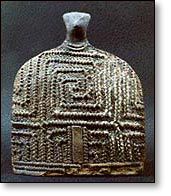nightingale and crow
The nightingale comes to the garden, no more the crow.
Light of my eyes, to the garden with you I will go.
Like lilies, like roses, we'll open out in blossom,
And we, like water running through gardens, will flow.
#1055: From Rumi's Kolliyaat-e Shams-e Tabrizi
Search word: nightingale
Yesterday, I ended with the mythical phoenix so today I searched for this nightingale. I also borrowed a book from my local library which has goddess images and symbols. Some of the very earliest of these depict bird-like women as shown below:
 |  |
To me, this seems to suggest that spirit or soul was very early associated with woman. Where that leads and what it means exactly is hard to say. In the second image above the bird goddess is associated with labyrinthine patterning evoking a sense of discerning the order in nature.
In Rumi's quatrain, the nightingale with its sweet song replaces the crow, a symbol found in alchemy and representing death, depression, darkness and sorrow. Adam Mclean describes it thus:
The Black Crow sometimes also the Raven is the beginning of the great work of soul alchemy. This indicates the initial stages of the alchemist's encounter with his inner space, through withdrawing from the outer world of the senses in meditation, and entering what is initially the dark inner world of the soul. Thus this stage is also described in alchemical texts as the blackening, the nigredo experience, and it is often pictured as a death process, as in the caput mortuum, the deaths head, or as some alchemical illustrations show, the alchemist dying within a flask. Thus in the symbol of the Black Crow we have the stepping out in consciousness from the world of the physical senses the restrictions that bind us to the physical body.
from The Birds in Alchemy
Crows are what I think of whenever I see Muslim women clad in the full black burqa, as lampooned in the cartoon below. I love this one because, for me, it represents a strong feminine wakefulness in contrast to masculine blindness. The spirit of the nightingale shines forth from those eyes which, I hope, will soon be released from these black prisons.

Rasmus Sand Hoyer: Muhammed cartoon for Jyllands Posten Denmark
A final word, referring back to the McLean article. I sense some colour symbolism in Rumi's quatrain since the alchemical nigredo (blackening) is followed by the albedo (whitening, as symbolized here by the lily) and rubedo (reddening, as symbolized by the red rose). An illustrated example of a personal journey through these stages can be found at Zade's alchemical meditations.



2 Comments:
The nightingale was a symbol for the lover, and a particular flower (I don't remember which specific one, rose?) symbolized the beloved. Here Rumi seems to be inverting the usual relationship between the lover (the person) and the beloved (God) by saying "we" will open out in blossom. Interesting.
Ah yes, Bob, thanks for noticing that. Al-Hallaj was cruelly martyred for saying "I am God". Rumi is very careful how he phrases it but he is constantly saying "I am God". You just have to listen closely enough.
Of course, there's a right way and a wrong way of saying "I am God" ...
Post a Comment
<< Home